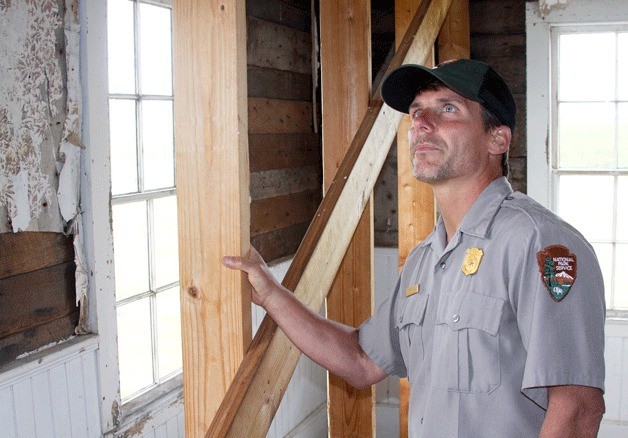Even the swallows wanted a closer look inside.
One stood on a window sill and peered through a second-story pane while Roy Zipp and Holly Richards led an informal tour through one of Whidbey Island’s most iconic, yet mysterious, historic structures this week.
It’s not often one gets to step inside the Ferry House, the empty, solitary landmark that rests above Ebey’s Landing and once served as an inn, tavern, post office, residence and Hollywood movie site.
Yet, opening the doors for the public to enter one of Washington’s oldest residential buildings is what is in store for one day next month and is why Zipp, Richards and others with the Ebey’s Landing National Historical Reserve will be hopping in the coming weeks to prepare for the rare event.
A Ferry House public opening will take place from 10 a.m. to 4 p.m., Saturday, Aug. 20. It was planned as part of the celebration of the National Park Service’s centennial anniversary.
Although private visits have occasionally taken place in recent years, this will be the first free public viewing of the Ferry House since May, 2010, according to Richards, the reserve’s outreach coordinator.
And the event is expected to attract a crowd.
Since parking is scarce, a shuttle will be used to transport guests from Coupeville High School to the Ferry House. Docents will be on hand to answer questions inside the house. And tents will be set up outside, featuring exhibits.
Tours will take place only on the first floor all day with an opportunity for self-guided tours in between. Guests are asked to reserve a spot in a tour online at www.nps.gov/ebla. Those interested in volunteering to help put on the event also may sign up at the website.
“What we’re hoping to do is raise awareness in the community about the house, about what it means and also about the work that the Park Service has been doing to preserve it,” said Richards, who’s only been inside the Ferry House twice.
“Since the Park Service took it over (in 2000), they’ve been doing very regular projects to the foundation, roof work, fixing gables, fixing windows.”
Zipp, who began as the operations manager for Ebey’s Landing National Historical Reserve a year ago, is fascinated by the Ferry House and its history.
It was built around 1860 as an inn by Winfield Scott Ebey to help provide income to help support his brother Isaac Ebey’s orphaned children.
Isaac Ebey came to Whidbey in 1850 and established the island’s first Donation Land Claim at what is now Ebey’s Landing but was murdered by raiding Indians from Southeast Alaska in 1857 at a site not far from the Ferry House.
The Ferry House was owned by only two families in 140 years — the Ebeys and Pratts — until the Nature Conservancy and later the National Park Service acquired it.
Frank Pratt Jr. bought the house from Harold Ebey in 1917.
It hasn’t been used as a full-time private residence since the 1930s, Richards said, adding that military personnel used the house for lodging from 1940-45 during World War II and an artist, Albert Heath, lived there from 1947-54.
For most of the last half-century, the house has remained mostly unchanged and mostly dormant, aside from occasional weekend visitors.
The house has no power or running water and is not connected to a septic system. There’s a two-seater outhouse in the back.
“One of the broader management questions we have is what to do with this house,” Zipp said.
“Leaving it in its current condition is not the best prescription for longterm preservation. There’s no water. There’s no electricity. There’s no septic system. There’s no systems here other than a cistern, I guess you’d call it.
“In terms of adaptively using this facility, which is a really good way of preserving historic structures, we don’t have a plan for that now but we’re open to ideas and I think we really need one.”
Zipp laughed at that notion but is serious about wanting public input.
“Our general management plan says we will interpret it as an external exhibit,” Zipp said.
“That’s OK in the near term. I think there could be some other possibilities for this place. It might make it a little more loved and taken care of.”



